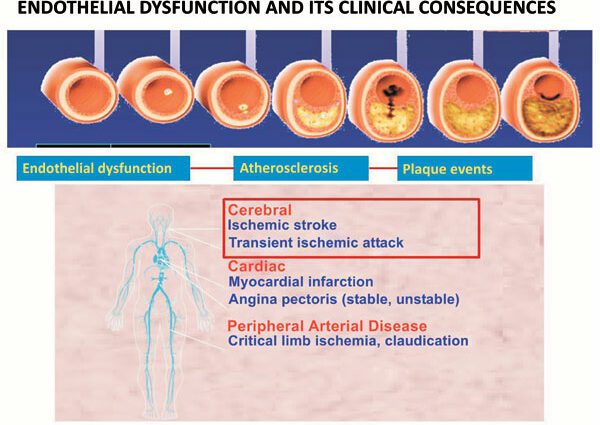Endothelial: what is endothelial dysfunction?
Endothelial dysfunction plays a significant role in the onset of diseases and in particular cardiovascular diseases. How to define the endothelium, what is its role? What are the risk factors that lead to endothelial dysfunction?
What is endothelial dysfunction?
The vascular endothelium forms a cellular barrier between tissue and blood. It is a key factor in the regulation of vasomotor phenomena of vascular permeability, tone and structure of vessels. Endothelial cells, in response to stimuli, generate regulatory molecules.
To reduce the cardiovascular risk, the endothelium is therefore a priority preventive and therapeutic organ.
Under the influence of aging and vascular risk factors, the endothelium can be activated and undergo functional modifications which can interfere with this function, one then speaks of “endothelial dysfunction”.
Endothelial dysfunction is defined as an abnormality in endothelium-dependent vasodilation caused by decreased availability of vasodilator factors, such as nitric oxide (NO), and worsening endothelial activation. This activation causes the release of adhesion molecules from the endothelium and macrophages (cells belonging to white blood cells, which infiltrate the tissues. During thrombosis and inflammation, these molecules are involved in the recruitment of leukocytes and l platelet adhesion.
The causes of endothelial dysfunction?
There are traditional and non-traditional risk factors.
Traditional risk factors
Among the traditional factors, endothelial dysfunction is observed in patients with cardiovascular risk factor, dyslipidemia, diabetes, high blood pressure. Tobacco, age, and heredity are also factors to consider.
Non-traditional risk factors
Among the so-called non-traditional factors, there is an imbalance in the production of vasodilator or vasoconstrictor factors which leads to an alteration in the vasodilator potential of the endothelium, the main marker of endothelial dysfunction.
Pathologies linked to endothelial dysfunction?
Endothelial function, thanks to the vasculoprotective effects of nitric oxide (NO), protects cardiovascular health.
Endothelial dysfunction is a factor that announces the onset of certain diseases:
- Cardiovascular events;
- Insulin resistance;
- Hyperglycemia;
- High blood pressure ;
- Dyslipidémie.
What treatments for endothelial dysfunction?
Helpful drugs include statins, which lower cholesterol even if cholesterol levels are normal or only slightly elevated, and in some cases aspirin or other antiplatelet drugs, drugs that prevent platelets from clumping together and from forming blockages in the blood vessels.
Some drugs used to treat high blood pressure and some drugs used to treat diabetes also reduce the risk.
Diagnostic
The methods of detecting endothelial dysfunction, invasive or non-invasive, functional or biological, are means of information which improve the knowledge of cardiovascular pathophysiology and which allow, to a certain extent, to evaluate the effectiveness of therapeutic interventions. on the prognosis of certain groups of patients.
In humans, endothelial dysfunction can be estimated by measuring:
- Plasma concentrations of the metabolites of dinitrogen monoxide (NO): a very unstable product, it cannot be determined in the blood, on the other hand the determination of its metabolites (nitrites and nitrates) is possible in the urine;
- Plasma concentrations of adhesion molecules: these molecules participate in the inflammatory process by allowing the adhesion of monocytes to the endothelium, then their migration into the internal wall of arteries and veins;
- Inflammatory markers.
Numerous biological markers also testify to endothelial dysfunction. Highly sensitive C-reactive protein (CRP) and extracellular superoxide dismutase (a powerful enzyme system) are among them.
How to prevent endothelial dysfunction
To prevent endothelial dysfunction, many strategies have been proposed including diet. The role of food constituents such as fatty acids, antioxidant vitamins, folate, vitamin D and polyphenols are highlighted.
- A low level of vitamin D leads to a high risk of cardiovascular disease and type 2 diabetes;
- Oxidative stress can affect endothelial function through inflammation and reduced NO availability;
- Lycopene, a powerful antioxidant, would reduce the markers for activating the endothelium, reactive C protein, and systolic blood pressure and would have beneficial effects on oxidative stress;
- Polyphenols provided mainly by fruits, vegetables, cocoa, tea and red wine. Their consumption is associated with a lower risk of cardiovascular disease.










